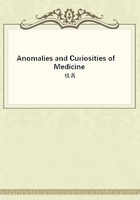
第11章
These statistics were from examination of 6000 cases of menstruating women. The last seven were found to be in women in the highest class of society.
Mehliss has made the following collection of statistics of a somewhat similar nature--Late Dentition. Late Late Male. Female. Lactation. Menstruation.
These statistics seem to have been made with the idea of illustrating the marvelous rather than to give the usual prolongation of these functions. It hardly seems possible that ordinary investigation would show no cases of menstruation between sixty and seventy, and seven cases between seventy and eighty; however, in searching literature for such a collection, we must bear in mind that the more extraordinary the instance, the more likely it is that it would be spoken of, as the natural tendency of medical men is to overlook the important ordinary and report the nonimportant extraordinary. Dewees mentions an example of menstruation at sixty-five, and others at fifty-four and fifty-five years. Motte speaks of a case at sixty-one; Ryan and others, at fifty-five, sixty, and sixty-five; Parry, from sixty-six to seventy seven; Desormeux, from sixty to seventy-five; Semple, at seventy and eighty seven; Higgins, at seventy-six; Whitehead, at seventy-seven; Bernstein, at seventy-eight; Beyrat, at eighty-seven; Haller, at one hundred;and highest of all is Blancardi's case, in which menstruation was present at one hundred and six years. In the London Medical and Surgical Journal, 1831, are reported cases at eighty and ninety-five years. In Good's System of Nosology there are instances occurring at seventy-one, eighty, and ninety years.
There was a woman in Italy whose menstrual function continued from twenty-four to ninety years. Emmet cites an instance of menstruation at seventy, and Brierre de Boismont one of a woman who menstruated regularly from her twenty-fourth year to the time of her death at ninety-two.
Strasberger of Beeskow describes a woman who ceased menstruating at forty-two, who remained in good health up to eighty, suffering slight attacks of rheumatism only, and at this late age was seized with abdominal pains, followed by menstruation, which continued for three years; the woman died the next year. This late menstruation had all the sensible characters of the early one. Kennard mentions a negress, aged ninety-one, who menstruated at fourteen, ceased at forty-nine, and at eighty-two commenced again, and was regular for four years, but had had no return since. On the return of her menstruation, believing that her procreative powers were returning, she married a vigorous negro of thirty-five and experienced little difficulty in satisfying his desires. Du Peyrou de Cheyssiole and Bonhoure speak of an aged peasant woman, past ninety-one years of age, who menstruated regularly.
Petersen describes a woman of seventy-nine, who on March 26th was seized with uterine pains lasting a few days and terminating with hemorrhagic discharge. On April 23d she was seized again, and a discharge commenced on the 25th, continuing four days. Up to the time of the report, one year after, this menstruation had been regular. There is an instance on record of a female who menstruated every three months during the period from her fiftieth to her seventy-fourth year, the discharge, however, being very slight. Thomas cites an instance of a woman of sixty-nine who had had no menstruation since her forty-ninth year, but who commenced again the year he saw her. Her mother and sister were similarly affected at the age of sixty, in the first case attributable to grief over the death of a son, in the second ascribed to fright. It seemed to be a peculiar family idiosyncrasy. Velasquez of Tarentum says that the Abbess of Monvicaro at the very advanced age of one hundred had a recurrence of catamenia after a severe illness, and subsequently a new set of teeth and a new growth of hair.
Late Establishment of Menstruation.--In some cases menstruation never appears until late in life, presenting the same phenomena as normal menstruation. Perfect relates the history of a woman who had been married many years, and whose menstruation did not appear until her forty-seventh year. She was a widow at the time, and had never been pregnant. Up to the time of her death, which was occasioned by a convulsive colic, in her fifty-seventh year, she had the usual prodromes of menstruation followed by the usual discharge. Rodsewitch speaks of a widow of a peasant who menstruated for the first time at the age of thirty-six. Her first coitus took place at the age of fifteen, before any signs of menstruation had appeared, and from this time all through her married life she was either pregnant or suckling. Her husband died when thirty-six years old, and ever since the catamenial flow had shown itself with great regularity. She had borne twins in her second, fourth, and eighth confinement, and altogether had 16 children. Holdefrund in 1836 mentions a case in which menstruation did not commence until the seventieth year, and Hoyer mentions one delayed to the seventy-sixth year. Marx of Krakau speaks of a woman, aged forty-eight, who had never menstruated; until forty-two years old she had felt no symptoms, but at this time pain began, and at forty-eight regular menstruation ensued. At the time of report, four years after, she was free from pain and amenorrhea, and her flow was regular, though scant. She had been married since she was twenty-eight years of age. A somewhat similar case is mentioned by Gregory of a mother of 7 children who had never had her menstrual flow.